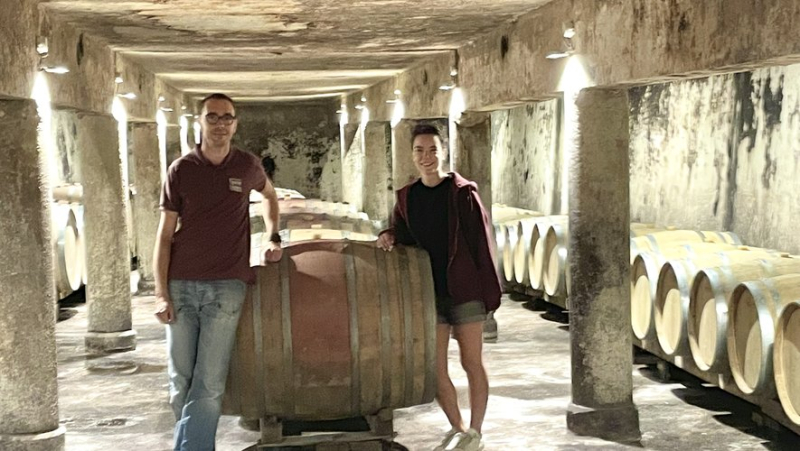The hundredth harvest has started at the Jonquières-Saint-Vincent cooperative cellar

Frédéric Sénac et Eugénie Jouffrey au premier jour des vendanges ! ALISSANDRE ALLEMAND – Alissandre Allemand
Les vendanges ont commencé ce mardi 20 août à la cave de Jonquières Saint-Vincent qui fête ses 100 ans. Malgré les maladies (mildiou et coulure), la campagne débute dans les temps pour les Vignerons créateurs. Rencontre.
Calm resonates in the long gray concrete corridors of the Jonquières-Saint-Vincent cooperative winery on this Tuesday, August 20. Rest after the hustle and bustle. This morning, the buildings that smell of freshly squeezed grape juice are celebrating their centenary. And what an anniversary! Since 3am, around forty employees of the cooperative winery of the Vignerons Créateurs (created in 2009 from the grouping of cooperative wineries of Bellegarde, Jonquières St-Vincent, Manduel and St Gilles) have been working fervently for this first day of harvesting.
“We started by bringing in the Syrahs and Grenaches”, smiles Frédéric Sénac, director of Vignerons Créateurs. Here, the harvest is done exclusively by machine. And the plots are picked according to the maturity of the berries and the needs of the cooperative winery. “We carry out a significant amount of work throughout the year on all the vines”. And when the harvest approaches, the phenolic maturity of the grapes is closely monitored. It is partly the latter that will kick off six weeks of intense work.
“This also allows us to anticipate what kind of wine we can make based on the grapes”, continues the director, who is also an oenologist.“A young Syrah that gives a lot and which we know will never offer a structured wine, we prefer to harvest it like whites and rosés, at night, when it is cool, to make a fresh and light red wine.” Moreover, the Grenache and Syrah brought in for this first day of the harvest will become rosés.
Precise steps for a praised wine
Fruits, which as soon as they arrive at the cellar, are poured into the presses and the grapes deliver with generosity their precious nectar. Almost immediately comes the time, for the whites and rosés, for settling. “It aims to purify the musts before fermentation. Depending on the year and the harvest conditions, several types of solid particles are found: stalks, pulp, seeds, but also unwanted debris such as soil or gravel. Thanks to this step, the solid materials are separated from the liquid and can be extracted”.
After about 24 hours, alcoholic fermentation can begin. “This is the transformation of sugar into alcohol. This step takes place in the cellar", explains Frédéric Sénac. The temperature of the vats is constantly monitored (it must not exceed 26°C). The gas created by fermentation causes the skins to rise to the top of the vat, which requires regular stirring, so that they give their aromas to the wine, which at this point has no color!
100 cooperative winegrowers
The time has come for maceration. After 8 to 10 days of fermentation, the wine in preparation will macerate. It is at this stage that the wine will take on its color. While it must last a long time for a red wine, it can only last a few hours for a rosé. Over about twenty days, the wine will capture the tannins, color and aromas of the pulp and skin. The vats will undergo racking and pumping over, in order to continuously stir the wine so that the maceration is effective. The run-off and malolactic fermentation will follow. In fact, the wine undergoes a second fermentation, activated by the heating of the vats which will allow the development of bacteria which will transform the malic acid into lactic acid. An operation which will significantly reduce the acidity of the wine and give it suppleness. Particularly important for the production of red wine, this stage will last about 1 month.
“At the end of October, beginning of November, we will put some of our whites and rosés in bottles”, smiles the director. “And the wines will be completely ready to be tasted. Whatever the color of the wine and its appellation, we keep our (red) wines for a maximum of 18 months, including aging".
Les Vignerons créateurs have approximately 1,300 ha of vineyard plots located between 6 appellations, all of which will be harvested by the beginning of October. The cooperative winery packages approximately 85 hl per year of wine, mainly red and rosé, classified, among others, as IGP or AOP, such as Costières de Nîmes and Clairette de Bellegarde, a dry white wine produced using organic farming methods.
I subscribe to read more




